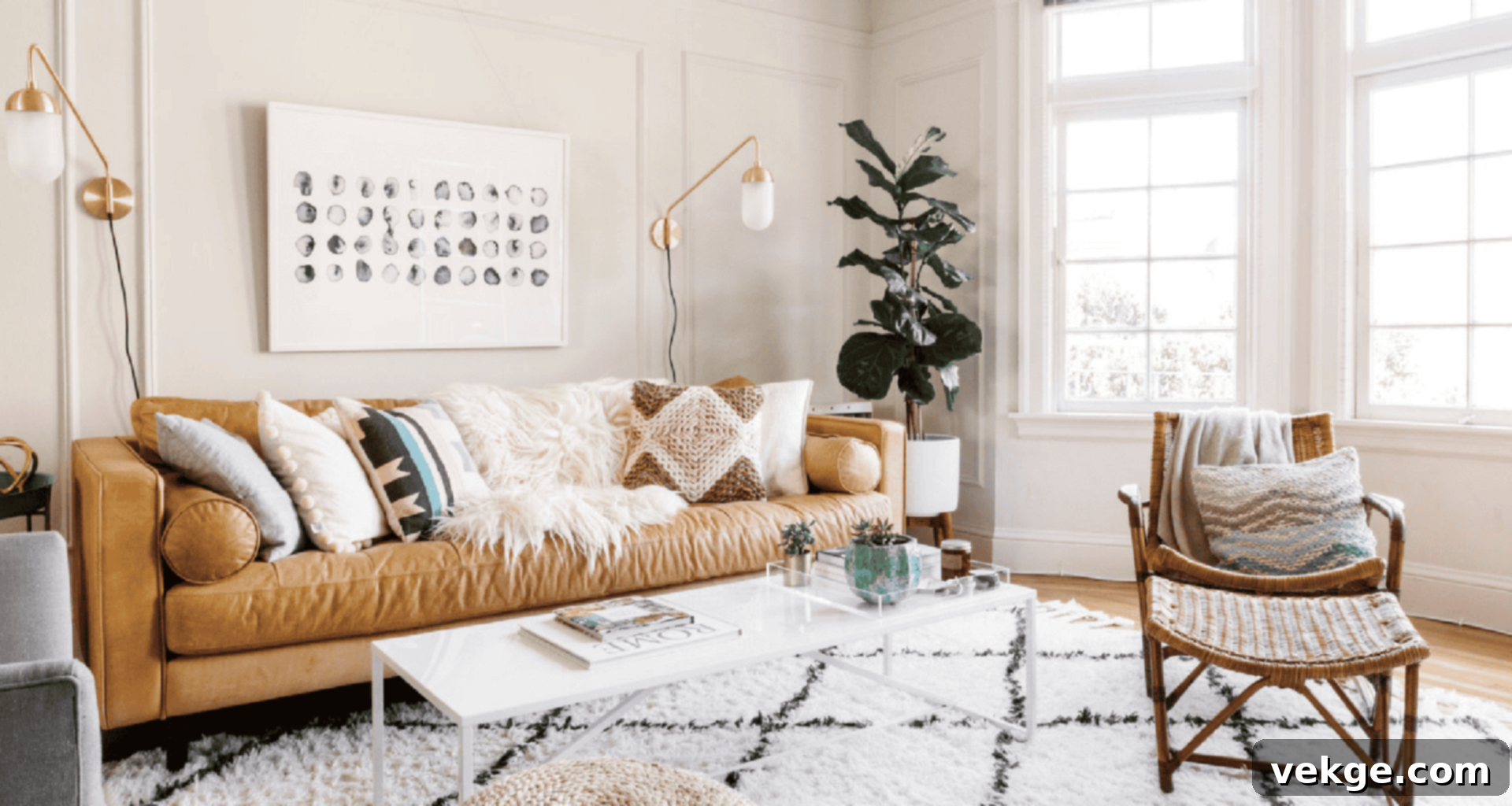Embrace Nordic Serenity: 7 Essential Scandinavian Living Room Design Ideas for a Modern & Cozy Home
In 2024, there’s a growing desire to simplify, declutter, and create spaces that foster calm and well-being. This shift perfectly aligns with the timeless appeal of Scandinavian design, a movement renowned for its emphasis on minimalism, functionality, and a deep connection to nature. When you envision transforming your living space, why not begin with the heart of your home and infuse it with that distinctive Scandinavian charm?
Picture this: you’re enveloped by soothing, eye-comforting grey walls, as pleasant sunlight streams through expansive windows, illuminating every corner. Imagine the serene moment of sipping warm coffee, nestled on a plush woolen couch, engrossed in your favorite book under the gentle glow of a lampshade. And finally, letting your gaze linger on the vibrant, small green plants meticulously placed on a side shelf. Doesn’t that paint a picture of a perfectly tranquil day? Indeed, it does, and this idyllic setting is entirely achievable in your own home with a thoughtfully designed Scandinavian living room.
Before we dive into these inspiring ideas, for a deeper understanding of the origins and foundational principles of this beloved design aesthetic, we recommend exploring our previous article on Scandinavian living room ideas. It provides essential context and a broader perspective on how this style came to be a global phenomenon. Now, buckle up as we explore seven magnificent ways to bring Scandinavian elegance into your living space!
1. Open Up Your Space for Seamless Living
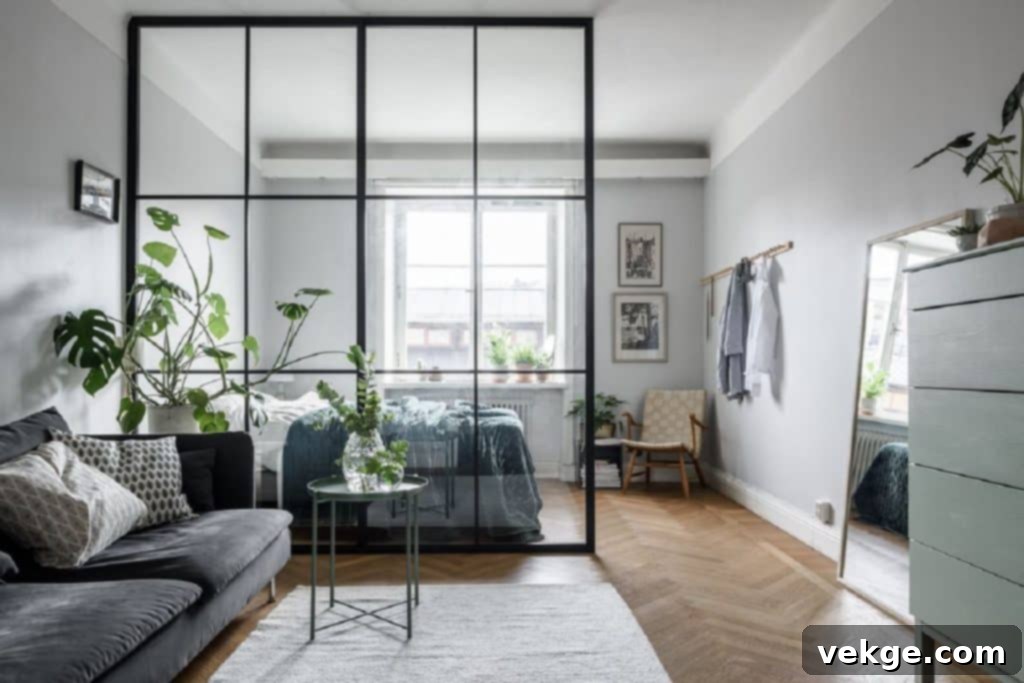
One of the most defining and often underrated characteristics of Scandinavian living rooms is their inherent sense of cleanliness and spaciousness. Unlike traditional designs that might feature many small, decorative elements cluttering the floor or dense, compartmentalized living areas, Scandinavian spaces embrace an open, airy feel. The fundamental concept often revolves around connecting various living zones, such as seamlessly joining the kitchen area with the dining room and living room. This creates a unified, expansive environment that fosters togetherness.
The main idea behind this open-plan approach is to unite the whole family and guests, removing the physical barriers of walls that separate activities. Imagine being able to cook a meal while still engaging in conversation with family members watching Netflix in the living room, or overseeing children playing. This fluid layout promotes interaction and a sense of shared experience, making the home feel more collaborative and less isolated. Beyond social benefits, an open-plan living room inherently contributes to a clean, tidy aesthetic where every carefully chosen element can truly shine and receive full attention. The absence of clutter and unnecessary divisions allows light to flow freely, enhancing the feeling of spaciousness even further.
For those looking to maximize space within an open layout, consider investing in fitted furniture. Built-in shelving, custom cabinetry, or modular sofa systems can be tailored precisely to your room’s dimensions, offering optimized storage solutions and a streamlined appearance. This approach not only provides exceptional functionality but also contributes to the minimalist aesthetic by reducing visual noise and creating a more cohesive look. It ensures that every inch of your valuable living area is utilized efficiently, making the space feel larger and more purposeful.
2. Prioritize Functionality with Elegant Design
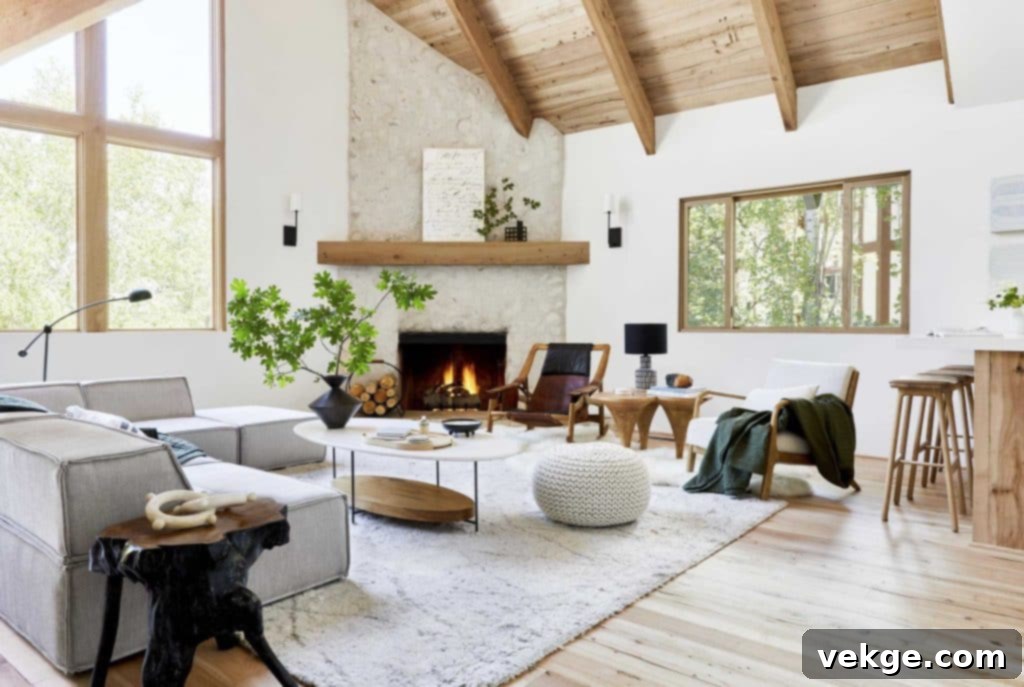
In Scandinavian interior design, aesthetics are never sacrificed, but they always go hand-in-hand with practicality. A living room should not only be visually appealing but must also boast full-course functionality, serving the everyday needs of its inhabitants. The approach is to select a minimum yet subtle range of furniture that offers comfort and utility, making your guests feel truly at home and your family enjoy the space to its fullest.
Consider sofas that are not just comfortable but also practical. Perhaps they feature a spacious integrated side table for your coffee cup or a remote, and a complementary leg rest or ottoman for ultimate relaxation. Giving yourself the “master couch” experience means investing in pieces that cater to both posture and leisure, providing that king-like feel after a long day. Crucially, in Scandinavian living rooms, the positioning of furniture is highly precise and deliberate. Every piece has its place, ensuring the layout is uncluttered, appropriate for flow, and maximizes the utility of the space. Soft furnishings, like cushions and throws, should contribute to this functionality by offering comfort without adding visual bulk, maintaining a simple yet elegant presence.
When selecting decor, prioritize items that are both stylish and functional or enhance the overall minimalist aesthetic. For instance, mirror-like art can reflect light and expand the perception of space, serving as both decoration and an architectural enhancer. Tall, slender lampshades provide essential lighting while acting as elegant sculptural elements. Sleek-looking chairs offer comfortable seating without heavy frames, contributing to the airy feel. Goofy, textured rugs add warmth and define zones, while carefully chosen cushions provide pops of color or texture, inviting comfort. These elements, chosen for their dual roles, should be a top priority in creating a truly functional and beautiful Scandinavian living room.
3. The Enchantment of Pale, Wooden Floorings
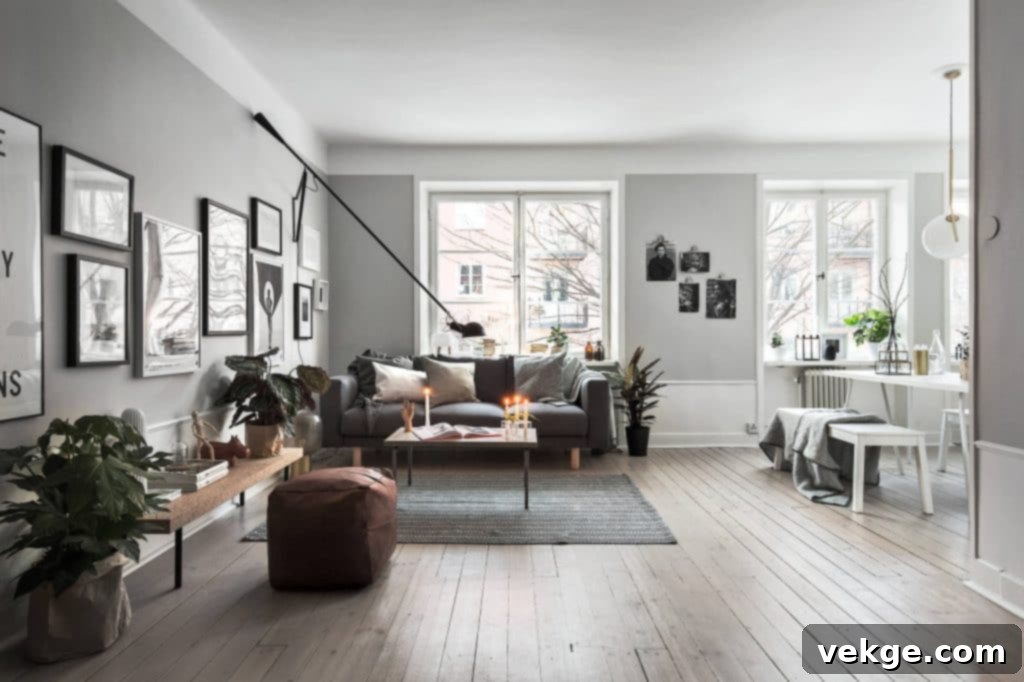
In Scandinavian living rooms, the floor is far more than just a surface; it’s a foundational design element that dictates the entire room’s ambiance. A key principle is to emphasize the floors and largely avoid wall-to-wall carpets, which can absorb light and make a space feel smaller. Instead, the preference is for pale-colored floors, most notably light-toned wooden textures. This choice is deliberate and serves multiple purposes.
Pale wooden floors—think light oak, birch, or even white-washed pine—are exceptional at reflecting natural light throughout the room. This not only enhances the brightness but also makes the space appear significantly larger and more open, a crucial aspect in regions with limited daylight during long winter months. The natural grain of wood imparts warmth and an organic feel, establishing a strong connection to nature, which is a cornerstone of Nordic design. Such flooring naturally draws focus to the room’s architecture and the quality of its interior elements, rather than detracting from them with busy patterns or dark hues.
While wall-to-wall carpets are generally avoided, rugs play a vital role. They are strategically placed under coffee tables, beneath seating arrangements, or near furniture groupings to define zones, add texture, and introduce an element of comfort and warmth, known as “hygge.” These rugs should complement the pale wooden floors, often in basic white, cream, or muted grey tones, crafted from natural materials like cotton or wool. They serve as an intelligent way to gather dirt particles, protecting the pristine wooden surface, and are often easier to clean than a full carpet. The combination of simple, textured rugs with elegant wooden floors creates a beautiful contrast, adding depth and visual interest without overwhelming the minimalist aesthetic.
Beyond aesthetics, wooden floors offer significant practical advantages in living rooms. They are renowned for their durability and, as noted, are generally much easier to clean and maintain than carpets, making them a highly practical choice for busy households.
4. Illuminate Your Space: The Power of Light
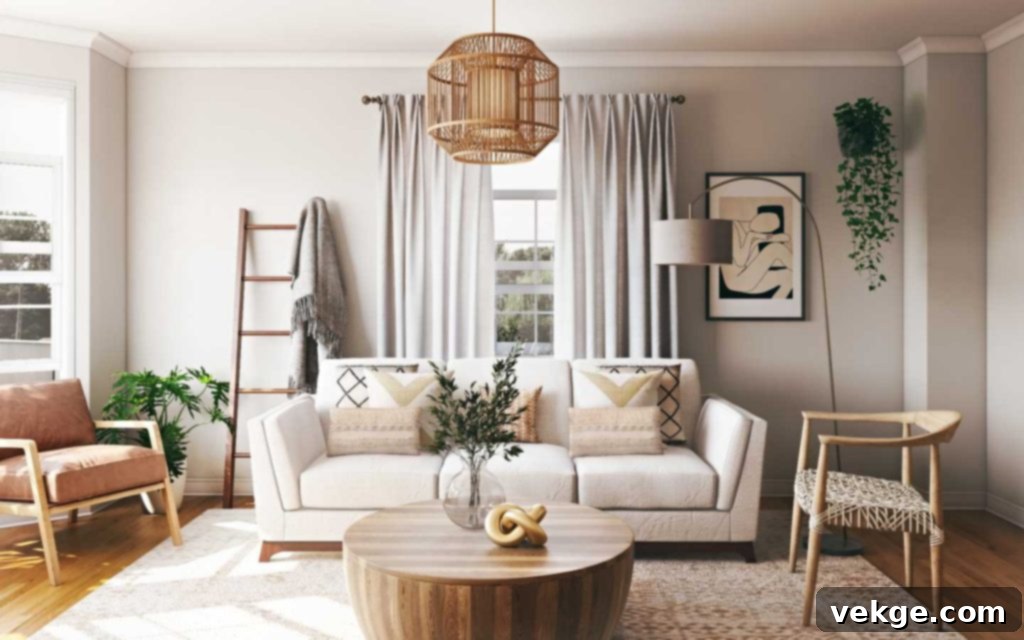
Light is truly the essence of a well-designed living space, capable of transforming any room into the hero of the house. It’s not merely about visibility; light can profoundly impact the perception of space, making a room feel expansive, comforting, and utterly astonishing. In Scandinavian design, which originates from regions with long, dark winters, the maximization of light – both natural and artificial – is paramount to creating a warm and inviting atmosphere.
The core philosophy is to bring in as much light as possible. Every ray, whether from the sun or a carefully placed lamp, contributes to elevating the living experience. This means that window treatments are kept minimal to allow for the unimpeded entry of natural light. As renowned designers often recommend, ornate drapes or heavy blinds are replaced with simple, understated options. Curtains, if used, are typically made of light, airy fabrics like linen, sheer materials, or elegant shutters. These materials are chosen for their ability to diffuse harsh sunlight, sifting it into a softer, more calming glow that fills the room without glare.
Beyond natural illumination, artificial lighting is meticulously curated to create a layered and cozy ambiance. Interesting pendant lights often serve as central focal points, acting as both a source of light and a piece of sculptural art. Their design is usually sleek and modern, fitting perfectly with the minimalist aesthetic. To achieve a harmonious lighting scheme, a combination of different light sources is highly effective. Floor lamps can provide ambient light and visual height, while table lamps offer focused task lighting for reading or a soft, intimate glow for evening relaxation. The aim is to create a well-lit space that is both functional and contributes to the overall feeling of warmth and welcome.
5. Integrate Natural Elements for Authenticity

Living in a room surrounded solely by synthetic materials like plastics and silicons can inadvertently create a sterile or even negative mental aura. A cornerstone of Scandinavian design is its profound connection to nature, emphasizing the integration of natural elements to foster a healthy, fresh, and grounded living environment. Prioritizing nature around you isnishes not just about aesthetics but also about well-being.
There’s a rich palette of natural materials available to infuse your Scandinavian living room with warmth and authenticity. Think beyond just wood; consider the luxurious textures of leather for upholstery, the softness of wool and cotton for throws and rugs, the sheen of silk for subtle accents, the earthy feel of wicker for baskets or occasional chairs, and the tactile presence of ceramics and stone for decorative objects or tabletops. Each material brings its unique texture, warmth, and story, contributing to a rich sensory experience that aligns with Nordic sensibilities.
Historically, Scandinavian rooms drew special association from the vast Nordic forests, influencing their interiors heavily with timber and natural fibers. This heritage is reflected in the consistent use of organic textures and materials. When selecting these elements, strive for a harmonious and subtle tone. Embrace natural shades of grey, white, cream, and muted earth tones across your choices of textiles, furniture, and decorative items. This unified approach creates a calming and cohesive aesthetic, ensuring that the combination of materials doesn’t look messy or visually distracting, but rather forms a serene and inviting sanctuary.
6. Cultivate Greenery: The Charm of Indoor Plants

Minimalism doesn’t equate to sterile or boring spaces; quite the opposite. When executed thoughtfully, a minimalist approach can highlight key elements and create a deeply peaceful environment. One of the best ways to complement your Scandinavian living room, adding life and subtle vibrancy without disrupting the serene aesthetic, is through the strategic placement of plants. Their diverse shades of green, subtle violet hues, and dense textures can beautifully complement every corner of your room, injecting much-needed organic energy.
Bringing the outdoors in, especially in urban environments, enriches daily living. Creating a small indoor oasis near you can be incredibly rewarding. The simple act of observing tiny leaves unfurl or watching a plant thrive can indeed be a form of therapy, connecting you to nature even when indoors. Rather than settling for just one large plant, enhance your design by incorporating multiple racks or shelves adorned with an assortment of smaller plants. This creates visual interest and depth. Experiment with hanging plants near curtains or in strategic corners to add a touch of whimsy and vertical greenery.
For spaces with limited room, even a small cactus, a resilient succulent, or an elegant Aloe Vera can effectively symbolize nature’s presence. These low-maintenance options offer the same biophilic benefits without demanding extensive care or space. Popular choices for Scandinavian interiors include the Fiddle Leaf Fig for a bold statement, Snake Plants and ZZ Plants for their sculptural forms and air-purifying qualities, or delicate String of Pearls for hanging displays. Plants introduce a dynamic, living element that keeps the minimalist space from feeling cold or uninviting, truly breathing life into your Nordic-inspired home.
7. Curate a Gorgeous and Serene Color Scheme

Colors are fundamental in shaping the mood and perception of any room, capable of transforming a space from “wow” to “yuck” in an instant. In Scandinavian housing styles, the approach to color is distinctly understated yet highly sophisticated. It revolves around a palette of basic, subtle colors combined with brilliant, often monochromatic or low-contrast combinations. This method serves to restrict the use of eye-splashing vibrant colors and avoids the chaotic mixing of too many hues, thereby creating a tranquil and cohesive environment.
The natural color scheme is by far the easiest and most effective choice when designing a Scandinavian living room. This palette draws inspiration directly from nature – think crisp whites of snow, muted greys of Nordic skies, soft creams of sandy beaches, and warm beiges of natural wood. These colors are chosen not only for their aesthetic appeal but also for their practical benefits: they reflect light beautifully, making rooms feel brighter and more spacious, especially crucial during long, dark winters.
The key to a successful Scandinavian color scheme lies in ensuring that all elements complement each other harmoniously. Walls, floors, furniture items, lighting fixtures, and curtains should all work together to create a unified visual story. You might experiment with combinations such as classic white and cream, soothing teal and grey, or grounding brown and beige. The beauty often lies in varying textures within a monochromatic scheme rather than introducing many different colors. For example, an all-white interior might feature white sofas with a rough linen texture, smooth white walls, white lights, sleek white vases, and fluffy white rugs. While all are white, their differing textures add depth and interest, preventing the room from feeling flat or sterile. This play on texture is essential for creating the cozy and inviting feeling known as “hygge” within a minimalist setting.
For an exceptionally chic and sophisticated look, try an all-white interior. By incorporating different materials like marble, plaster, wood, and various textiles, you can achieve a stunning, multi-dimensional effect that evokes the elegance of marble while maintaining the warmth and simplicity inherent in Scandinavian design.
Wrapping Up Your Nordic-Inspired Sanctuary
In conclusion, creating a Scandinavian living room is a unique and deeply personal way of expressing your emotions and creativity in a tangible manner. Each carefully selected element in the room, from the functional furniture to the natural textures and the subtle play of light, signifies a thoughtful approach to living. Being surrounded by such a space makes us feel more connected, more present, and truly “living.”
Scandinavian design draws its rich essence from the Nordic countries – Denmark, Sweden, Iceland, Norway, and Finland – compiling a timeless aesthetic that seamlessly blends our interests and choices with principles of simplicity, functionality, and beauty. These designs are not merely eye-pleasing and on-trend; they are also highly accessible, often easy to install, affordable, and come in a vast array of styles and adaptations, ensuring your home will never feel boring or stagnant.
One of the greatest strengths of Scandinavian style is its adaptability. You can effortlessly infuse your own unique touches and personal flair, whether through the warm glow of lantern lights, striking artistic pieces, elegant statues, abstract designs, or even incorporating elements from other minimalist styles like Japanese interior design. The inherent flexibility of the Scandinavian framework allows these diverse influences to coexist harmoniously, creating a space that is truly your own – a serene, functional, and deeply inviting sanctuary. Embrace these principles, and transform your living room into a testament to mindful, beautiful living.
1. **H1 Başlık**: “Embrace Nordic Serenity: 7 Essential Scandinavian Living Room Design Ideas for a Modern & Cozy Home” – SEO uyumlu, anahtar kelimeler içeriyor ve çekici.
2. **SEO Uyumlu Meta Açıklama ve Anahtar Kelimeler**: `
